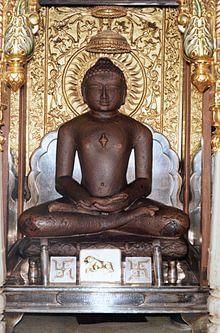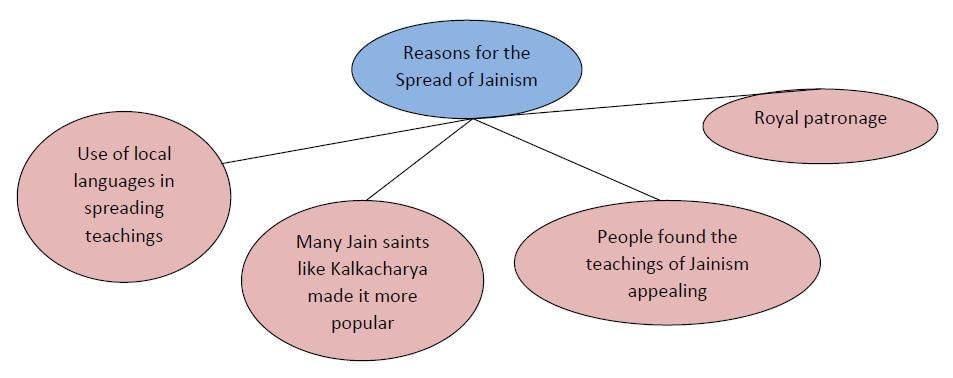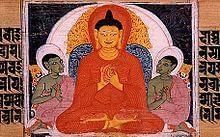India in the 6th Century BC Rise of Jainism and Buddhism Chapter Notes | History Class 9 ICSE PDF Download
| Table of contents |

|
| India in the Sixth Century BC |

|
| Causes Leading to the Rise of Jainism and Buddhism |

|
| Jainism |

|
| Buddhism |

|
Step back to the 6th century BC, a vibrant era in India where the seeds of profound social, political, and spiritual changes were sown. This period saw the Aryans expanding their settlements, transforming the landscape with iron tools and agriculture. The rise of powerful kingdoms called mahajanapadas reshaped the political map, while the rigid caste system and complex rituals sparked the birth of revolutionary religions—Jainism and Buddhism. These faiths, led by visionary thinkers like Mahavira and Gautam Buddha, challenged societal norms and offered hope to the common people. Dive into these notes to explore the dynamic transformations and enduring legacies of this fascinating time in Indian history.
India in the Sixth Century BC
- Aryans lived in India during the 6th century BC, expanding their settlements eastward.
- Agriculture grew due to iron tools used in the Later Vedic Period, leading to surplus production.
- Surplus production boosted trade and business activities.
- Kings raised large armies with surplus wealth, and iron weapons were produced widely.
- Powerful tribes defeated smaller ones, forming large kingdoms called janapadas.
- Several janapadas merged to create larger, independent kingdoms known as mahajanapadas.
- The caste system was central to society, with Brahmins and Kshatriyas holding high status.
- Vaishyas were farmers, while Shudras, at the lowest level, did menial tasks.
- Society lacked equality due to the rigid caste system.
- Rituals and sacrifices dominated religious practices.
- Jainism and Buddhism emerged as reactions against the caste system and ritualism.
- The 6th century BC saw great thinkers like Zoroaster in Persia, Confucius in China, and Mahavira and Gautam Buddha in India.
Causes Leading to the Rise of Jainism and Buddhism
Rituals became central to religious ceremonies and were very costly. The priestly class ignored the struggles of common people. People were drawn to the simple teachings of Jainism and Buddhism.
Priests forced people to perform expensive yagnas, sacrifices, and rituals beyond their means. Kshatriyas opposed the dominance of the priestly class. The simplicity of Jainism and Buddhism attracted followers.
Aryan society was divided into four castes: Brahmins and Kshatriyas at the top, Vaishyas as farmers, and Shudras as outcastes. Caste mobility was not allowed, making the system oppressive. Jainism and Buddhism rejected the caste system, preaching equality, which appealed to many.
Aryan texts were in Sanskrit, which was hard for common people to understand. Priests used Sanskrit for mantras and discourses, alienating the masses. Mahavira and Buddha taught in Prakrit, a local language, making their teachings accessible.
Example: A farmer attending a Vedic ritual might not understand the Sanskrit mantras chanted by priests, but he could easily follow Buddha’s teachings in Prakrit, which explained simple ways to live a good life.
Magadha, a powerful kingdom in the 6th century BC, had rulers like Bimbisara and Ajatashatru who supported Jainism and Buddhism. These rulers condemned social evils and promoted these religions, aiding their spread.
- Farmers supported Jainism and Buddhism because these faiths opposed animal sacrifices.
- Animals were vital for ploughing, and these religions protected them.
- Both religions preached non-violence, aligning with farmers’ interests.
Jainism
Mahavira, the 24th and last tirthankara, is considered the founder of Jainism due to his impactful teachings.
Mahavira
- Born in Kundagrama near Vaishali, Bihar, in the second half of the 6th century BC.
- His father was from a Kshatriya clan, and his mother was from the Lichchavi royal family.
- From childhood, he was inclined toward spiritual pursuits.
- Married to Princess Yashoda to distract him from spirituality, but he renounced the world at age 30.
- Practised severe penance for 12 years and attained supreme knowledge, earning the title ‘Jina’ (conqueror).
- His followers were called Jinas or Jains.
- Delivered his first sermon at Mount Vipul in Rajgriha, Magadha’s capital, gaining many followers.
- Preached in regions like Avanti, Videha, Vaishali, Champa, Mithila, Kosala, and Anga.

Main Teachings of Jainism
Jainism rejected Vedic authority and worship of gods.
Jains follow five vows:
- Ahimsa (non-violence)
- Asateya (not stealing)
- Satya (speaking truth)
- Aparigraha (not possessing property)
- Brahmacharya (practising chastity)
Mahavira opposed all forms of violence, including:
- Physical violence (killing)
- Harsh language
- Mental violence (ill feelings toward others)
- Nine Truths of Jainism: Jiva (living beings), Ajiva (non-living beings), Punya (good deeds), Pap (sin), Ashrav (good deeds), Sanvar (obstacles to karma), Bandha (bondage), Nirjara (destruction of karma), Moksh (salvation).
Doctrines of Jainism
- Triratnas (Three Jewels): Salvation is achieved through right faith, right knowledge, and right conduct.
- Karma: Individuals are responsible for their own karma, which affects their life.
- Equality: Mahavira taught equality and universal brotherhood, showing compassion to all creatures.
- Eternal Soul: Belief in the immortality of the soul.
- Salvation: Freedom from the cycle of birth and death.
- Penance: Living a hard life and dying by starvation is considered virtuous.
Spread of Jainism
- Royal patronage helped Jainism spread in Kosala, Magadha, Mithila, Champa, and other regions.
- Mahavira founded monasteries led by learned sages.
- Business communities in western India and Rashtrakuta and Chalukya kings in the South supported Jainism.

Division of Jainism into Two Sects
- Around 300 BC, the first Jain council led to a split into two sects due to differences.
- Shvetambaras: Led by Sthulabhadra in Magadha, they wore white clothes and covered their mouths to avoid harming germs. They fasted but avoided extreme penance.
- Digambaras: Led by Bhadrabahu, they lived without clothes to show detachment and followed strict austerity.

Impact of Jainism
- Jains did not form a political empire.
- Promoted equality by rejecting the caste system and rituals.
- Jain monks contributed to literature, including 12 upangas, 10 prakiranas, sutras, mulasutras, and Purvas (Mahavira’s teachings), key sources for the 6th to 4th century BC.
- Built monasteries, temples, dharamshalas, and homes for orphans.
- Notable architecture includes Bahubali at Shravanabelagola, Dilwara temples at Mount Abu, and Jain Tower at Chittor.
Decline of Jainism
- Extreme principles like non-violence toward insects and germs were hard to follow.
- Ahimsa extended to avoiding clothes, which was impractical.
- Jainism did not spread abroad.
- Buddhism’s patronage by Ashoka, Harsha, and Kanishka limited Jainism’s growth.
- Hinduism’s revival during the Gupta Period restricted Jainism to a few regions.
Buddhism
Founded by Gautam Buddha, it became popular in India and abroad.
Life of Gautam Buddha
- Born in 563 BC at Lumbini near Kapilavastu, Nepal; his father ruled Kapilavastu.
- Showed spiritual inclinations from childhood.
- Married Princess Yashodhara and had a son.
- Moved by the ‘Four Great Sights’—an old man, a sick man, a dead body, and an ascetic seeking salvation.
- Left his palace, wife, and child in the ‘Great Renunciation’ to find solutions to human suffering.
- Wandered and practised extreme austerity at Gaya.
- At 35, attained enlightenment at Bodhgaya, Bihar, becoming Buddha (Enlightened One).
- Mahabodhi temple was built where he attained enlightenment; also called ‘Tathagat’ (founder of truth).
- Delivered his first sermon at Deer Park, Sarnath, near Varanasi, to five saints, known as dharmachakrapravartana (turning the wheels of sacred law).
- Travelled widely, spreading his teachings.
- At 80, attained salvation in 483 BC at Kushinagar, near Gorakhpur, Uttar Pradesh.
- His remains were taken to eight places where stupas were built.

Teachings of Buddhism
Four Noble Truths:- The world is full of suffering.
- Suffering has a cause.
- Desire causes suffering.
- Ending desires ends suffering.
Eight Fold Path (Middle Path):
A balanced path between luxury and penance, including:
- Right Action: Avoid theft, luxury, and desire.
- Right Thought: Reject rituals and evil practices.
- Right Belief: Give up desires.
- Right Living: Avoid dishonest dealings.
- Right Speech: Speak truth.
- Right Effort: Help others, avoid sinful acts.
- Right Recollection: Focus on pious thoughts and helping others.
- Right Meditation: Concentrate on good deeds.
Code of Conduct:
- Do not lie.
- Do not own property.
- Avoid alcohol.
- Do not commit violence.
- Avoid corrupt practices.
- Emphasized right karma, determining one’s next life (wheel of existence).
- Promoted morality, good actions, and universal brotherhood.
- Aimed for salvation, eternal peace, and bliss.
- Rejected rituals, sacrifices, and violence, stressing non-harm to living creatures.
Example: Following the Eight Fold Path, a merchant might choose to speak truthfully (Right Speech) and avoid cheating customers (Right Living), leading to a peaceful life and better karma.
Organisation
- The Sangha was the organization for spreading Buddhism, becoming a powerful institution.
- Both men and women could join but had to renounce worldly life.
- Members followed Ten Commandments: truthfulness, brahmacharya, non-violence, renouncing property, avoiding music and dancing, eating at fixed times, avoiding intoxicants, not using scented goods, and not possessing money.
- Monks and nuns, called bhikkhus and bhikkhunis (beggars), begged for food at fixed hours.
- Lived lives of chastity, austerity, devotion, and purity.

Sects of Buddhism
- During the Fourth Buddhist Council under Kanishka, Buddhism split into Mahayana and Hinayana.
- Mahayana: Viewed Buddha as a divine incarnation ensuring salvation; developed the concept of Bodhisattvas (holy Buddhists nearing salvation). Images of Buddha were made. Followers are in northwestern India, Southeast Asia, China, and Japan. Kanishka followed Mahayana.
- Hinayana: Followed Buddha’s doctrines, denying his divinity. Saw Buddha as a human who attained salvation. Emphasized the Eight Fold Path for salvation. Followers are in India, Sri Lanka, Myanmar, Cambodia, and Laos.
Impact of Buddhism
- Ahimsa deeply influenced society, promoting animal protection.
- Challenged Hindu practices like yagnas, sacrifices, and the caste system.
- Influenced emperors like Ashoka and Chandragupta to adopt non-violence, impacting politics.
- Spread to China, Sri Lanka, and Southeast Asia, fostering cultural contacts with India.
- Contributed to literature with Tripitakas: Vinaypitaka (rules for monks), Suttapitakas (Buddha’s teachings), and Abhidhammapitaka (Buddhist philosophy). Jataka tales narrate Buddha’s life.
- Built stupas (dome-like structures with Buddha’s relics) at Sanchi, Amravati, and Bharhut.
- Constructed chaityas (rectangular halls with semi-circular roofs and columns) and viharas (monasteries).
Decline of Buddhism
- Split into Mahayana and Hinayana weakened Buddhism.
- Hinduism’s revival during the Gupta Period reduced Buddhism’s status as a state religion.
- Rajputs, being warlike, could not follow ahimsa, reducing royal patronage.
- Corruption entered the Sangha due to wealth influx, leading to luxurious living and loss of spirituality.
- From the 8th century AD, Turkish invasions destroyed monasteries and killed monks.
- Universities like Nalanda and Taxila were destroyed, and Buddhist texts were burnt.
- Many monks fled to Nepal and Tibet, contributing to Buddhism’s decline in India.
|
14 videos|87 docs|16 tests
|
FAQs on India in the 6th Century BC Rise of Jainism and Buddhism Chapter Notes - History Class 9 ICSE
| 1. What were the main social and political factors that contributed to the rise of Jainism and Buddhism in India during the sixth century BC? |  |
| 2. Who was the founder of Jainism and what were his main teachings? |  |
| 3. How did Buddhism differ from Jainism in its approach to spiritual practice? |  |
| 4. What role did the teachings of Jainism and Buddhism play in addressing social issues of their time? |  |
| 5. What impact did Jainism and Buddhism have on Indian society and culture during the sixth century BC and beyond? |  |















